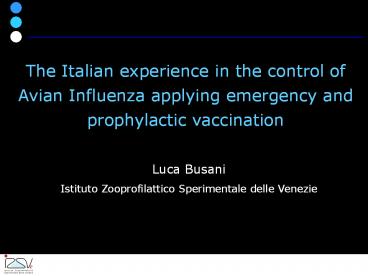Influenza aviaria - PowerPoint PPT Presentation
Title:
Influenza aviaria
Description:
The Italian experience in the control of Avian Influenza applying emergency and prophylactic vaccination ... (H5 H7 virus subtypes) Reduction of farm density, ... – PowerPoint PPT presentation
Number of Views:167
Avg rating:3.0/5.0
Title: Influenza aviaria
1
The Italian experience in the control of Avian
Influenza applying emergency and prophylactic
vaccination
Luca Busani Istituto Zooprofilattico Sperimentale
delle Venezie
2
The AI challenge in Italy
- High density of susceptible species (turkeys)
in a limited area (Densely Populated Poultry
Area-DPPA) - Wetlands and resting sites for migratory
waterfowl in close proximity of this DPPA - Several introductions of LPAI viruses from wild
birds resulting in some cases in major epidemics
3
ITALY - VENETO AND LOMBARDY Distribution of
poultry holdings
Mallard population in Italy 110,000 birds/year
_at_ 3.300 poultry holdings _at_ 95 million bird places
4
Italy AI outbreaks from 1997 to 2005
- 1997-1998 HPAI H5N2 8 outbreaks, backyard
flocks, prompt eradication - 2000 LPAI-HPAI H7N1, total costs 500 million
- 2000-2001 LPAI H7N1 78 outbreaks
- 2002-2003 LPAI H7N3 388 outbreaks
- 2004 LPAI H7N3 28 outbreaks (September-November)
- 2005 LPAI H5N2 15 outbreaks (April-May)
Total direct costs 170 million euros
5
LPAI prevention control strategies
- Increase of farms bio-security level
- Prompt detection of any AI virus introduction in
- Poultry
- Wild birds
- Vaccination (H5H7 virus subtypes)
- Reduction of farm density, mainly turkey farms
(long term strategy)
6
More than 1000 farms More than 31 million birds
Veneto
Lombardia
VACCINATION AREA
7
Vaccination data management system
Reports to decision makers
Laboratory data
Poultry populations data
Central data collection and analysis
Monitoring activity
Poultry vaccination data
8
Numbers of vaccination in Italy (2000-2006)
2000- 2002 2003 2004 2005 2006
Capons 41,000 301,000 268,000 192,000 211,000
Guinea Fowls - - 84,000 75,000 41,000
Cockerels - 1,061,000 1,261,000 - -
Laying hens 6,534,000 26,830,000 13,263,000 7,577,000 5,459,000
Turkeys 16,303,000 47,242,000 36,171,000 28,318,000 10,908,000
Total (doses) 23 million 75 million 51 million 36 million 17 million
Cost () 4 million 13 million 9 million 6 million 3 million
Vaccination-related costs 35 million payed by
the farmers
9
Weekly incidence rate of LPAI H7N3 outbreaks
From 31/12/02 vaccination of turkeys (H7N1)
R03.0 IC (2.3- 3.9)
R00.6 IC (0.5-0.7)
10
LPAI epidemics and vaccination in Italy
- emergency vaccination
- preventative vaccination
- c,d) poor adherence to the vaccination protocol
- c) 17 flocks vaccinated only once or twice,
instead of three times as scheduled - d) all flocks vaccinated only once
11
Conclusions I
- Emergency and prophylactic AI vaccination can
reduce financial losses due to AI epidemics - In order to maintain trade, vaccination must be
coupled with monitoring and aimed at eradication - Wild birds and backyard flocks must be included
in the monitoring programs - The problems related to AI vaccines and
vaccination must be considered when intervention
is planned
12
Conclusion II
- Control of AI in DPPAs requires a coordinated
territorial strategy including surveillance,
early detection and prompt intervention and
vaccination should be part of it - This strategy must be adapted to the field
conditions - It requires dedicated resources
- The sustainability in the long period is the
major drawback
13
Grazie per lattenzione
Luca Busani Istituto Zooprofilattico delle
Venezie CREVcrev.lbusani_at_izsvenezie.itStefano
Marangon Istituto Zooprofilattico delle
Veneziesmarangon_at_izsvenezie.it






























